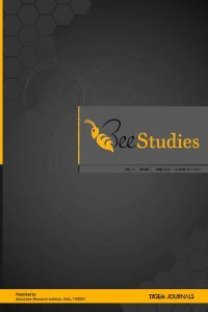Pollen Preference of Honeybees Depending on Protein Contents
Honey bee (Apis mellifera L.), Lamium purpureum L., pollen choice protein, Trifolium repens L.,
___
- Andrada, A. C., & Tellería, M. C. (2005). Pollen collected by honey bees (Apis mellifera L.) from south of Caldén district (Argentina): botanical origin and protein content. Grana, 44(2), 115-122.
- Anonymous, (2008). Türkiye’nin Çayır ve Mera Bitkileri. Ankara: The Ministry of Agriculture and Rural Affairs, General Directorate of Agricultural Production and Development.
- Anonymous, (2013). Turkish Plants Data Service. TÜBİVES. Retrieved from http://turkherb.ibu.edu.tr
- AOAC, (2002). AOAC Official method 990.03: Protein (crude) in animal feed. Combustion method.
- Başdoğan, G., Sağdıç, O., Daştan, T., Düz, G., & Acar, S. (2019). Farklı Bölgelerden Toplanan Arı Polenlerinin Fizikokimyasal Özellikleri ve Şeker Profillerinin Belirlenmesi. Avrupa Bilim ve Teknoloji Dergisi, (15), 627-631.
- Çelemli, Ö. G., Barkan, P., Özenirler, Ç., Demiralp, D. Ö., & Sorkun, K. (2017). Protein Analysis of Anzer Bee Pollen by Bradford Method. Mellifera, 17(1): 21-32.
- Davis, P. H. (1965-1985). Flora of Turkey and East Aegean Islands (Vol. 1-9). Edinburg, UK: Edinburg University Press.
- Erdogan, Y., & Dodologlu, A. (2005). Importance of Pollen In Life of Honeybee (Apis mellifera L.) Colonies. Uludag Bee Journal, 5(2):79-84.
- Ghosh, S., Jeon, H., & Jung, C. (2020). Foraging behaviour and preference of pollen sources by honey bee (Apis mellifera) relative to protein contents. Journal of Ecology and Environment, 44(1), 4.
- Guler, A. (2017). Bal Arısı (Apis mellifera L.) Yetiştiriciliği, Hastalıkları ve Ürünleri. ISBN: 978-605-84656-3-3. Bereket Akademi Yayınları. 419s.
- Gungor, I., Atatoprak, A., Ozer, F., Akdag, N., & Kandemir, N. I. (2007). Bitkilerin Dünyası. Bitki Tanıtım Detayları ile Fidan Yetiştirme Esasları. Ankara.
- Komosinska-Vassev, K., Olczyk, P., Kaźmierczak, J., Mencner, L., & Olczyk, K. (2015). Bee pollen: chemical composition and therapeutic application. Evidence-Based Complementary and Alternative Medicine: eCAM, 2015, 297425. https://doi.org/10.1155/2015/297425.
- Louveaux, J., Maurizio, A., & Vorwohl, G. (1978). Methods of melissopalynology. Bee world, 59(4), 139-157.
- Lunau, K. (2000). The ecology and evolution of visual pollen signals. Plant Systematics and Evolution, 222: 89–111.
- Özkök, A., & Sorkun, K. (2016). Pollen Morphology of Opium Poppy (Papaver somniferum L.) Pollen Collected by Honeybees and Honeybees Tendency to Opium Poppy Flowers. Mellifera, 16(2), 55-60.
- Öztürk, A. İ., Yalçın, L. İ., & Tutkun, E. (2001). Arıcılık. YAYÇEP, 33(1), 101.
- Radev, Z. (2018). Variety in protein content of pollen from 50 plants from Bulgaria. Bee World, 95(3), 81-83.
- PalDat, (2015). Palynological Database. Retrieved from https://www.paldat.org
- Roulston, T. H., Cane, J. H., Buchmann, S. L. (2000). What governs protein content of pollen: pollinator preferences, pollen–pistil interactions, or phylogeny? Ecological Monographs, 70(4), 617–643.
- Sammataro, D., & Avitabile, A. (1998). The Beekeeper's Handbook (Third Edition). Cornell Univ. Press.
- Sawyer, R. (1988). Honey identification. Cardiff Academic Press.
- Sorkun, K. (2008). Türkiye'nin nektarlı bitkileri, polenleri ve balları. Palme Yayıncılık.
- Taha, E. K. A., Al-Kahtani, S., & Taha, R. (2019). Protein content and amino acids composition of bee-pollens from major floral sources in Al-Ahsa, eastern Saudi Arabia. Saudi Journal of Biological Sciences, 26(2), 232-237.
- Tellería, M. C., Salgado-Laurenti, C. R., Marinozzi, L. A., Apóstolo, N., & Pérez, B. (2019). Protein content of pollen of asteraceae collected by honey bees. Bee World, 96(4), 104-107.
- Tutkun, E. (2011). Arıcılık Tekniği. Ankara, Turkey: Önder Matbaacılık Ltd. Şti.
- ISSN: 2757-5438
- Yayın Aralığı: Yılda 2 Sayı
- Başlangıç: 2009
- Yayıncı: Arıcılık Araştırma Enstitüsü Müdürlüğü
Pollen Preference of Honeybees Depending on Protein Contents
Şeref CINBIRTOĞLU, Fazıl GÜNEY
Şeref CINBIRTOĞLU, Fazıl GÜNEY
A Research on the Breeding Activities of Organic Beekeeping Enterprises
Tunay KILIÇİN, Gökhan AKDENİZ, Salim AKTÜRK, Dilek KABAKCI, Ümit KARATAŞ, Soner ÇANKAYA
Tunay KILIÇİN, Gökhan AKDENİZ, Salim AKTÜRK, Dilek KABAKCI, Ümit KARATAŞ, Soner ÇANKAYA
The Effects of Propolis on Human Health
